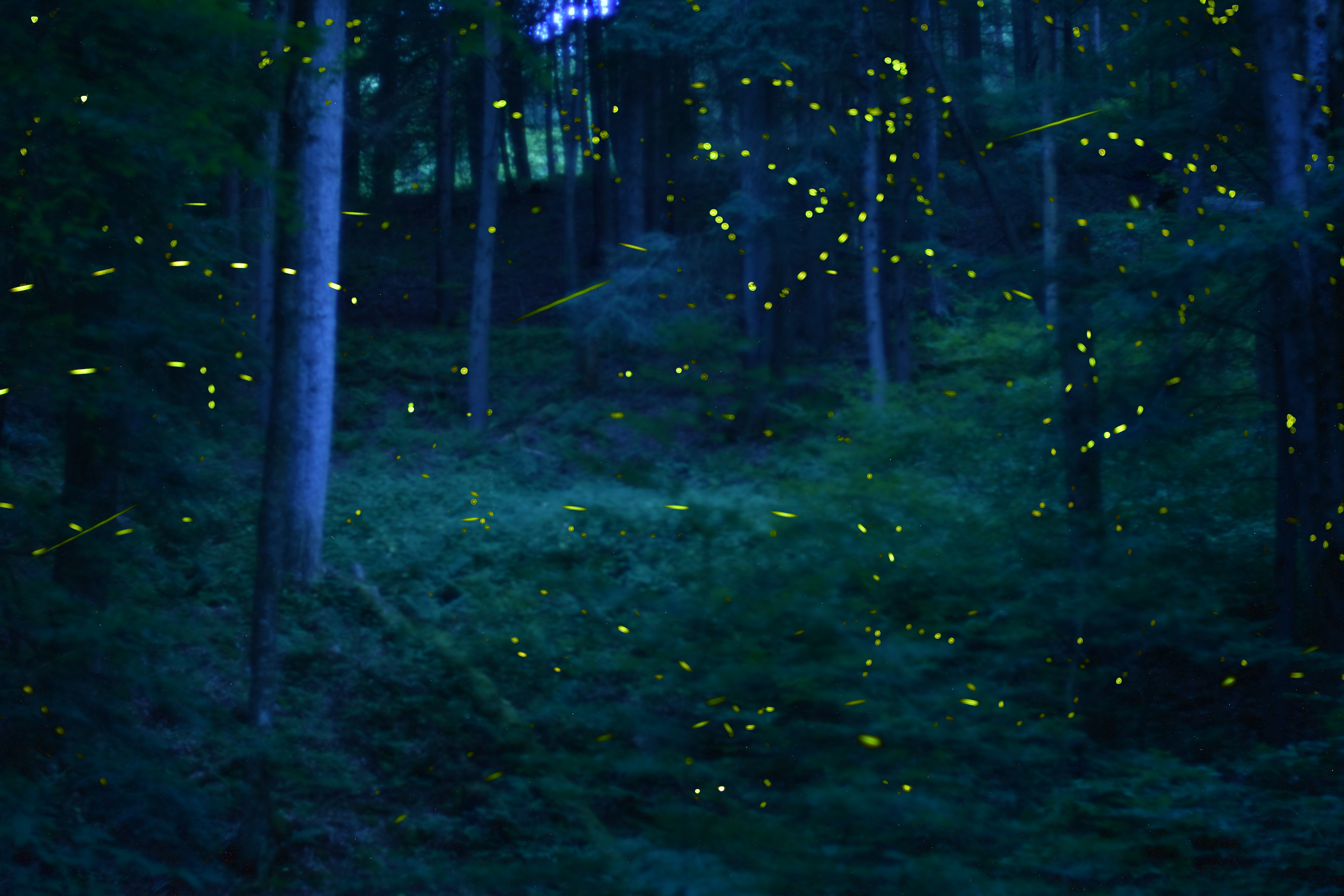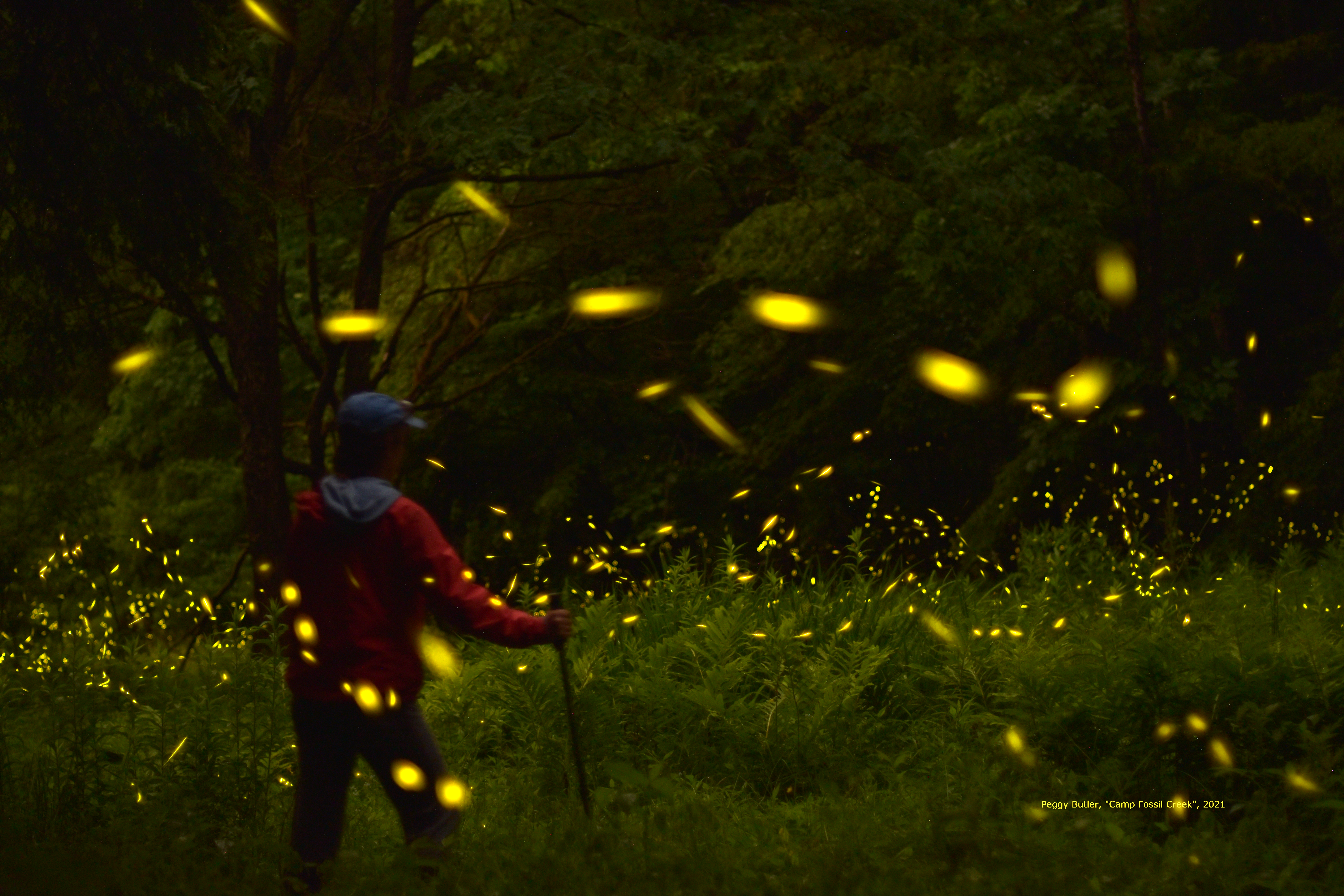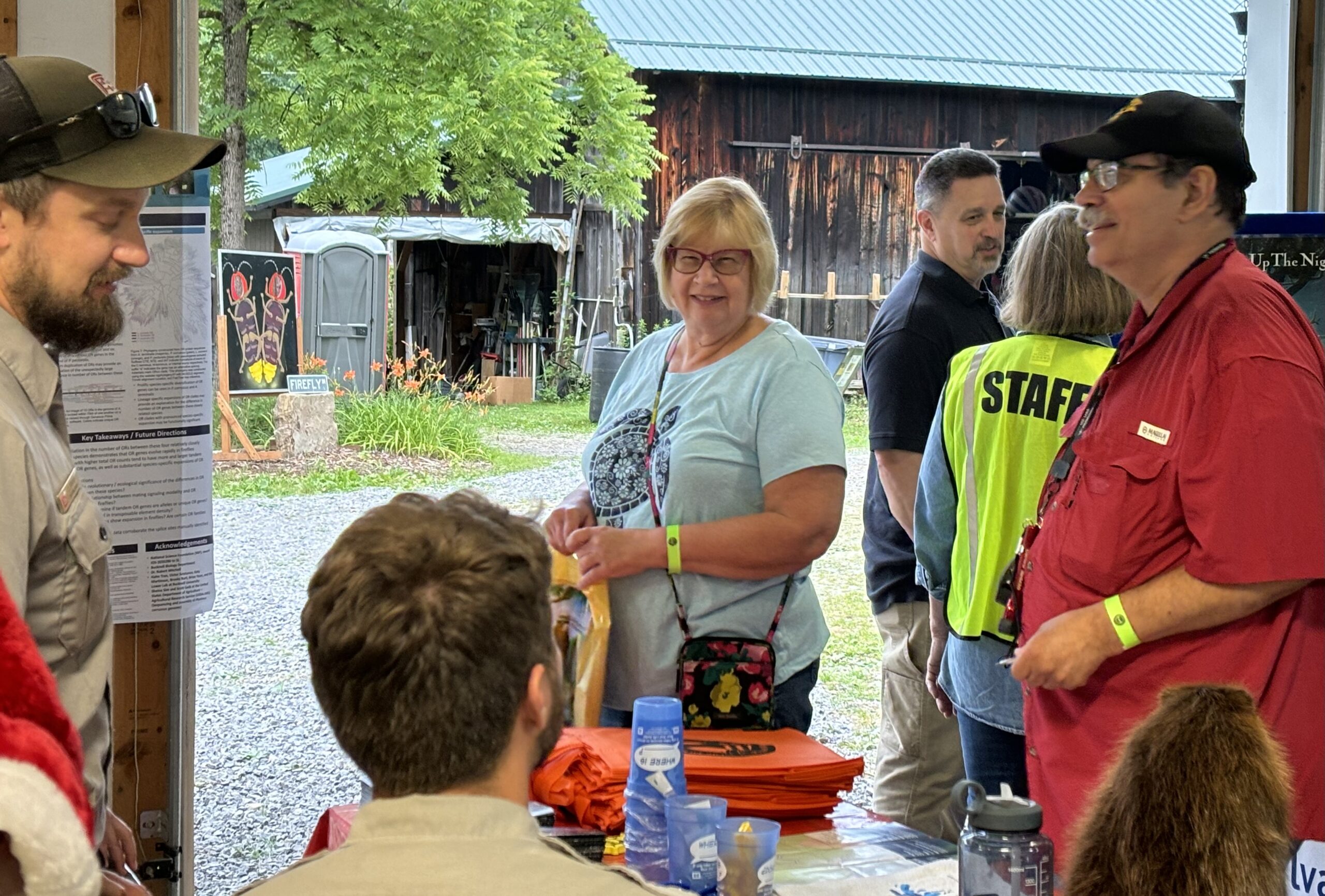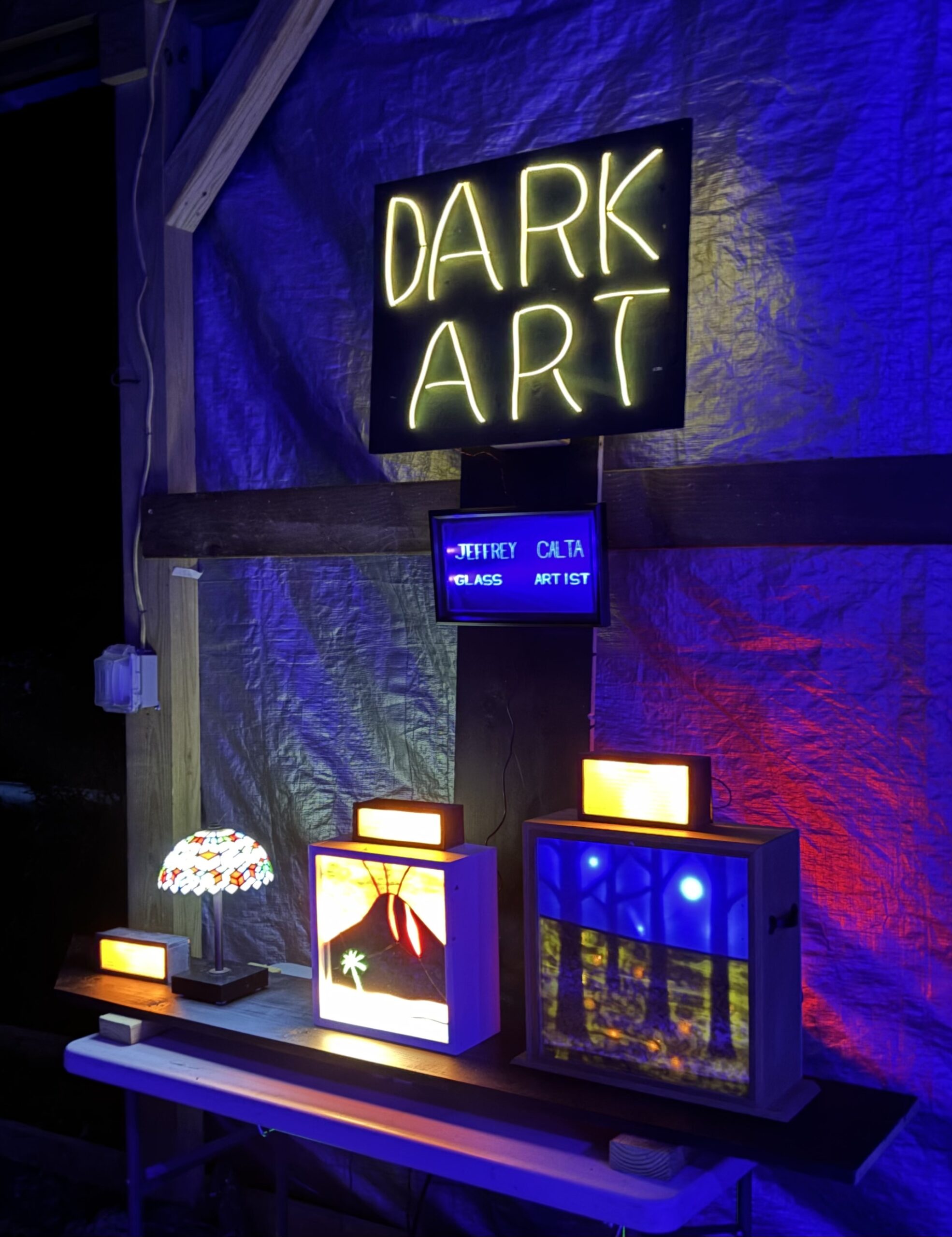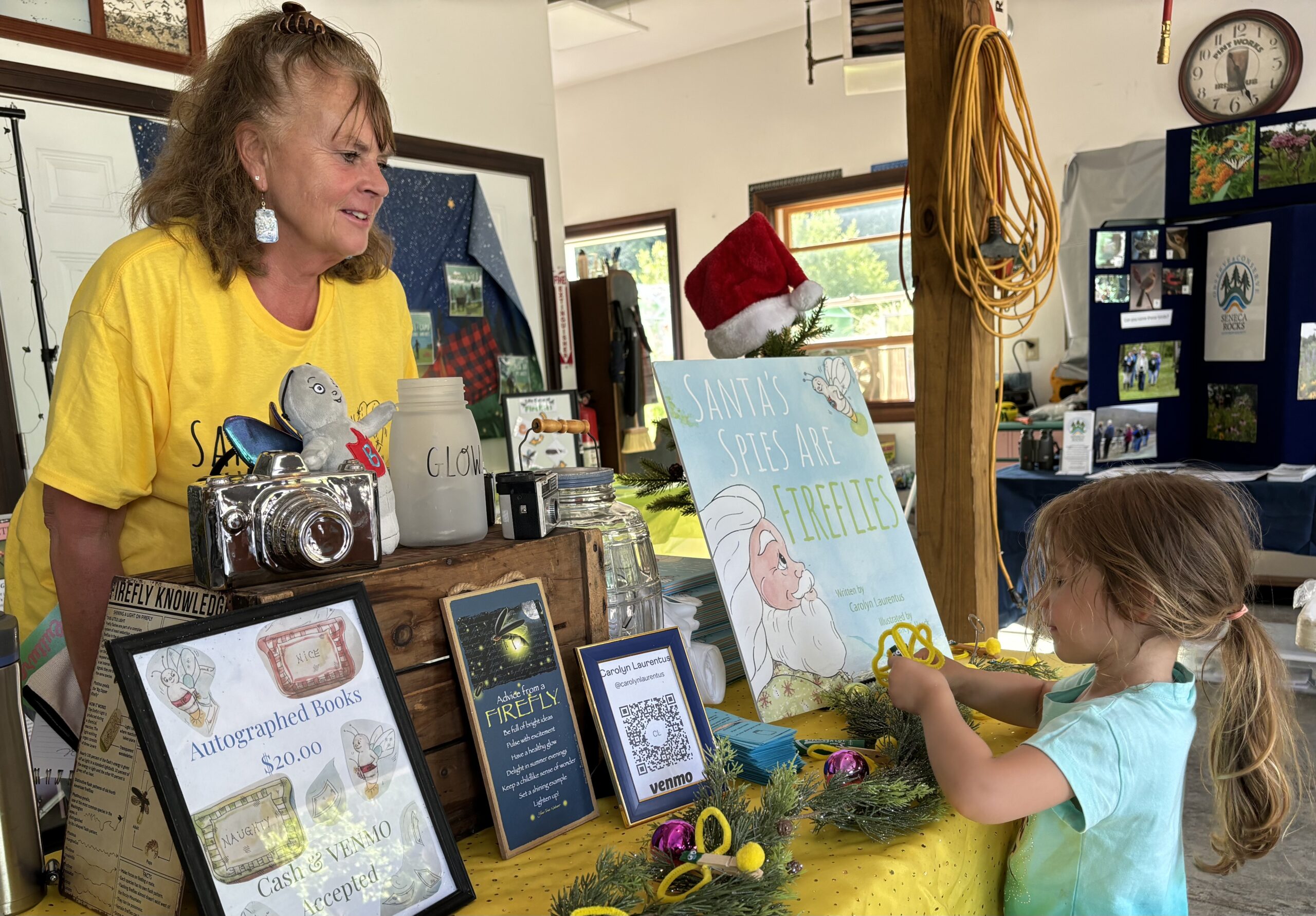All images courtesy of Peggy and Ken Butler, PA Firefly Festival
Imagine this: as you’re camping in the middle of a dark forest, you spot something unusual – a series of twinkling lights that are all in sync with one another, appearing like a string of Christmas lights or an eerie almost-sentient creature flashing out a message.
As strange as it might seem, this is the Photinus Carolinus firefly, a type of Synchronous Firefly. Synchronous species of fireflies are rare, so rare that they can only be seen in a handful of places around the world… including the Pennsylvania Wilds.
The P. Carolinus breed of Synchronous firefly was only recently discovered in the Allegheny National Forest in 2012 by a team of biologists. Now visitors come from all over the world to view the Pennsylvania Synchronous Firefly Season, which lasts from the summer solstice until the second week of July.
Annual mating displays of over fifteen different species of firefly happen during this time throughout the Allegheny National Forest, including the mating season for P. Carolinus.
What does a Synchronous Firefly flashing pattern look like?
The flashing pattern of a Synchronous Firefly is difficult to describe, and it’s almost impossible to catch on film. If you try to photograph or video it with your typical phone camera, you will undoubtedly be disappointed. If you see a Synchronous Firefly swarm, the best advice is to simply enjoy it and not try to capture it on film. However, that makes it difficult to find videos of these fantastic fireflies.
Synchronous fireflies have a distinct flashing pattern, different from other species. The Photinus Carolinus species flashes in a series of 5 to 8 bursts of light, followed by a pause of a few seconds. The synchronous pattern that you see from the fireflies flying through the air are made by the male fireflies. The female fireflies, which are nestled on the ground waiting for a mate to find them, answer back with two flashes of light. Then the pattern begins over again.
The flashing may start out as random. However, as more fireflies join in, the period of darkness between the flashes becomes more synchronized.
The PA Firefly Festival
The PA Firefly Festival (PAFF) attracts media attention from around the world, but only 150 lucky lottery winners are able to experience it each year. Held the last week in June on Route 666 in Kellettville (outside Tionesta) in Forest County, inside the Allegheny National Forest, the event is held on the property of Peggy and Ken Butler.
It’s been happening since 2011, with an interesting story of sudden growth followed by a thoughtful decrease in allowed visitors.
“The event has evolved over the years,” says Peggy. “When we first started the festival, we never thought so many people would want to come and see fireflies.”
Peggy and Ken’s property had been simply a bed and breakfast in 2011. Some scientists booked rooms to study the local fireflies within the Allegheny National Forest. Everyone, including the scientists, were surprised to find that Photinus Carolinus existed not just within the ANF, but a group of them specifically were found right in the backyard of Peggy and Ken’s B&B!
They began a festival, which quickly grew to around a thousand people trying to catch a glimpse of the special fireflies.
Changing how the PA Firefly Festival shows off (and protects) the fireflies
As more people came to the festival, the Butlers and the group of PA Firefly Festival volunteers worried that all of the people would threaten to extinguish the very species of fireflies they were celebrating. The thousands of trampling feet would inevitably step on the female fireflies that were waiting on the ground, and the volunteer group determined that the festival should be limited.
“We learned after the COVID pandemic that we didn’t need a music festival, with food trucks and vendors. People just wanted to come see the fireflies, but the demand was so high it was not sustainable for our organization and more importantly for the fireflies,” says Peggy.
“We have learned that fireflies take up to two years to develop. The firefly you see today started as an egg 2 years ago, and has been living in the soils, trees and leaf litter ever since,” she says. “Once this process became clear to us, we knew we could no longer allow hundreds of people on our property and in the forest. The impacts were detrimental to the lifecycle and would likely destroy the very thing people were desperate to see.”
“Now, we strictly limit our audience sizes and access to the firefly habitats on the private property,” Peggy explains. “We conduct a lottery in order to give the public a fair and equitable chance to join in the events. We had over 2500 applications this year (with at least 2 people per application) for essentially 150 spots over 4 events and 9 private tours. We restrict the events to a limited time (4 hours) and a specific location, so as to protect the sites over which we have control.”
If you want to be there for the 2025 event, it’s a good idea to sign up for the PA Firefly Festival newsletter. You’ll be one of the first to know when registration opens again. You can sign up for the newsletter and learn more about the festival at www.pafireflyevents.org.
Education at the PA Firefly Festival
The PA Firefly Festival isn’t simply a chance to camp out and party. The festival, now limited to just 150 lucky lottery winners, is an educational and valuable experience. There are firefly exhibits, live music, experts, art displays, and guided firefly walks.
Firefly experts and scientists are on hand to explain how fireflies light up, along with why these Synchronous Fireflies are so special. They take participants along a creek bank to spot all types of fireflies, pointing out different species. Before the walk, participants are given special instructions of how to cause the least amount of damage to the firefly habitat: walking in a single file line, locating female fireflies on the ground and ensuring that others in the line don’t step on her, and limiting lights to only red lighting that is less distracting for the fireflies during their mating season.
Each night of the PA Firefly Festival ends with a guided walk into the woods behind the Butler family’s house, where a group of Synchronous Fireflies can be seen. Bleachers are available for folks to have a seat, or they can bring their own chairs. Over recent years, bluetooth earpieces have been handed out and experts make comments on what participants are seeing. The forest is extremely dark, making it easy for enthusiasts to spot these incredible glowing creatures.
“People have to be careful not to love something so much that they destroy the habitats and the insects themselves with human impact and activity. The tourism industry estimates that 1 million people around the world seek out firefly tourism annually,” says Peggy. “Tourists need to educate themselves about the fireflies and the places that they are going to go in order to see them.”
“They may attend a festival or a firefly program, or they may need to hire a guide in order to learn more before they go out to find them on their own. This is for the protection of the fireflies, but also for the people,” she says. “Some of the areas are very remote and if a person isn’t physically fit enough for hiking distances IN THE DARK unassisted, then they probably shouldn’t be going into the forest. They may have to be satisfied with sitting in a park or on their porch to view fireflies.”
Where else can you see Synchronous Fireflies?
Photinus Carolinus and other Synchronous Fireflies (such as those known as Snappy Snycs) can be found in a small number of other locations around the United States, including the Great Smoky Mountains National Park in North Carolina and Tennessee, Congaree National Park in South Carolina, Rocky Fork State Park in Tennessee, and Oak Ridge Wildlife Management Area in Tennessee. The fireflies can also be found in other parts of the world, specifically in the Southeast Asian mangrove forests.
However, the Allegheny National Forest is a prime location to see these Synchronous Fireflies. Although the PA Firefly Festival is a wonderful chance to get a deep educational experience and get a guided tour of the firefly habitat, you can still see the fireflies by yourself if you are careful.
Even outside of the PA Firefly Festival, there have been reports of people seeing Synchronous Fireflies in the general Allegheny National Forest area.
If you book a cabin or campsite in the Allegheny National Forest in late June or early July, keep your eyes out for these special Synchronous Fireflies!
“The firefly tourism demand in Pennsylvania is increasing and not showing signs of decline. We’ve had films, photo shoots and media coverage from the likes of the BBC’s Sir David Attenborough, the Howard Hughes Medical Institution, Netflix, National Geographic and the Associated Press,” says Peggy. “However, we are not the only place in the PA Wilds or Pennsylvania for that matter that has fireflies.”
“We neither want to nor can we provide all the firefly programs for Pennsylvania. We encourage other parks, outfitters and private individuals to provide firefly programs and guided tours,” Peggy says. “We also encourage artists, restaurant/bar owners, lodging and shop owners to create firefly themed works, specials and promotions. PAFF is willing and able to train and share information with other organizations, outfitters or individuals and help them develop their own programs, events or tours.”
Tips for protecting the fireflies
“We have precious and unique fireflies (the Synchronous firefly and the Chinese Lantern firefly) that deserve respect, admiration and protection. We want people to know and understand why the firefly is important and to take steps to protect them and the environment,” says Peggy.
”The firefly is a bio-indicator species that tells us that if they are present in a habitat, all is well, and the habit is healthy and well balanced. They are also an ‘umbrella’ species, meaning that if they inhabit a place other species of flora and fauna will benefit from the same habitat. Creating and protecting space for fireflies will help everyone.”
Provide a habitat
Set aside a part of your garden or yard where you don’t mow as often. Let things get a little wild! Fireflies and other important insects need the shelter of taller grass and moisture from water or dew. This will become a place where fireflies and other creatures can happily call their home.
Avoid pesticides
Pesticides and herbicides can kill fireflies and other creatures that are beneficial for your backyard environment. Avoid using pesticides, and opt to use more natural methods instead to take care of pests.
Turn off outdoor lights
Especially during the firefly mating season, fireflies are particularly sensitive to artificial lights. Help fireflies find their mates… not your twinkling artificial lights! Turn off those outdoor lights, or limit them to pointing only at a specific area. When walking and looking for fireflies, use only red filtered lights or let your eyes adjust to the darkness. Even a single flash of artificial light can prohibit a firefly from mating that night.
Use the Seven Principles of Leave No Trace
Want to help protect not just fireflies but other wildlife? Want to help keep the outdoors safe and respect others who are enjoying nature? Follow the Seven Principles of Leave No Trace to help protect and cherish these natural spaces. Learn more at PAWilds.com/lnt.
“PAFF supports and adheres to the 7 principles of Leave No Trace when leading firefly walks,” says Peggy. “We are also members of the United States Firefly Tourism Luminary Council (USFTLC), which follows the guidelines for tourism set by the International Union for Conservation of Nature (IUCN) under the Firefly Specialist Group. These principles and guidelines, if followed , will help to protect the habitats and future firefly generations.”
Learn more about fireflies
You can learn more about fireflies and the PA Firefly Festival at www.pafireflyevents.org.
You can also make a donation at the PA Firefly Festival website. PAFF is a non-profit organization. Your contributions help support the quarterly newsletter, educational programs in schools, firefly interns and further the research in Pennsylvania and throughout North America.
“The world is wanting to see fireflies in the PA Wilds,” says Peggy. “The PA Wilds could become a ‘Firefly Mecca’ for tourists, film makers, and researchers. All we need to do is keep the lights OFF!”



